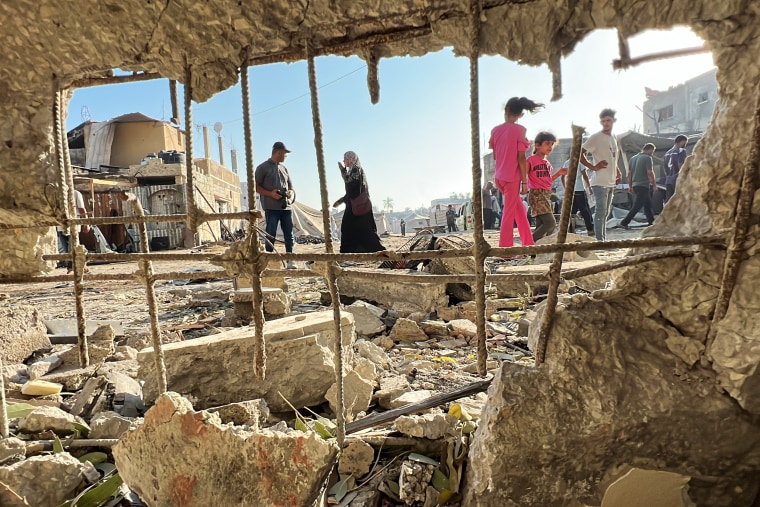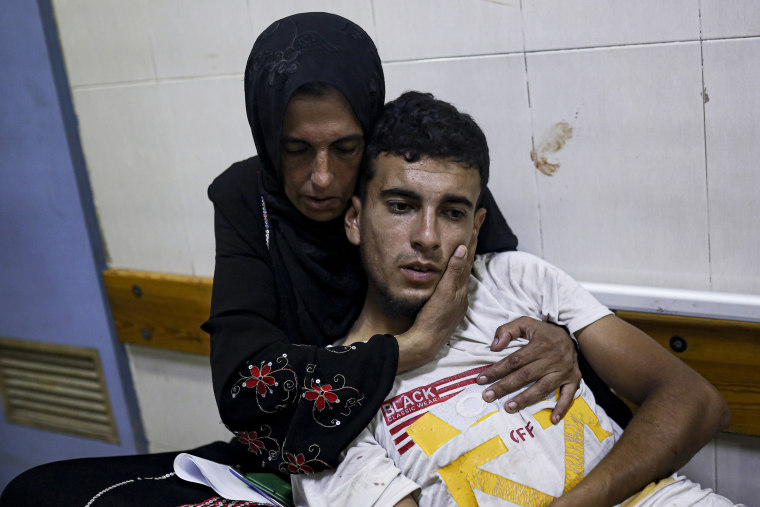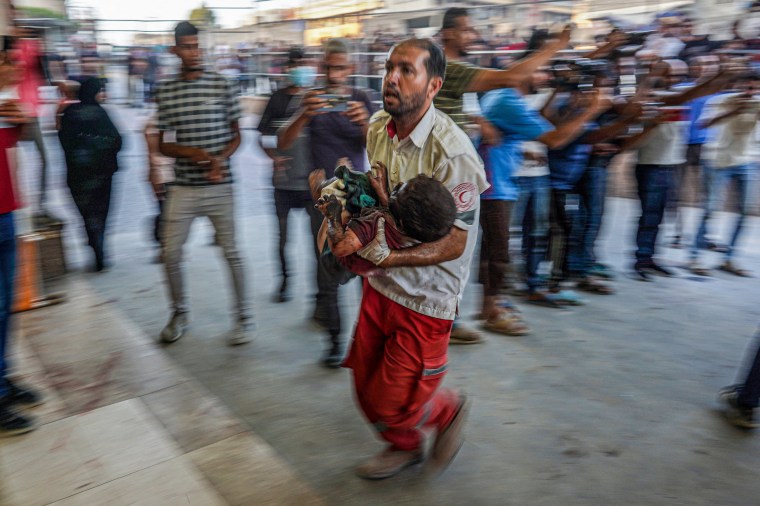At least 25 people were killed and dozens more wounded in the fourth strike on or near a school in the Gaza Strip in just four days, health officials in the enclave said late Tuesday.
Dozens of people were gathered outside the Al-Awda school, in Abasan, a city in southern Gaza’s Khan Younis governorate, when the strike hit, witnesses told NBC News’ crew shortly after the attack. Some of them were watching a soccer match, they said.
Footage released by Al Jazeera and authenticated by NBC News showed a game being played in the school's courtyard before a blast rings out. As screams ring out, people dash in all directions.
Shortly afterward, an NBC News crew filmed bloodied patients, including young children, filling the hallways. Many were lying on the ground, wailing in agony.
“I was walking, when suddenly I found myself flying,” Ahmed Wessam Kediah, 14, said as he lay on a stretcher, his bloodied leg wrapped in bandages. “I saw all the wounded. Just body parts.”

Later, at the scene of the strike, the NBC News crew filmed a young boy wailing over two body bags, with several others laid out on the ground.
“They killed my father and my uncle,” he cried. “They died. They died. They died.”
The Israel Defense Forces said Tuesday it had struck a Hamas fighter who had taken part in the Oct. 7 attack using precise munition. It said it was looking into reports that civilians were harmed near the Al-Awda school, which it noted was “near the location of the strike.”
Hamas condemned the strike in a statement. As efforts ramped up in Qatar’s capital, Doha, to negotiate a cease-fire deal between Israel and Hamas, the militant group later warned that Israeli attacks could threaten the progress of the talks.
If a deal is reached, it would bring an end to nearly nine months of fighting in Gaza, where local health officials say more than 38,000 people have been killed. It would also mean hostages taken during Hamas’ Oct. 7 terrorist attack, in which 1,200 people were killed and around 250 others were kidnapped, would be released.
'Death & misery'
The strike was one of at least “4 schools hit in the last 4 days,” Philippe Lazzarini, commissioner-general of the United Nations’ Palestinian refugee agency, UNRWA, said in a post on X on Wednesday.
“Schools have gone from safe places of education & hope for children to overcrowded shelters and often ending up a place of death & misery,” he said.
On Saturday, a strike hit an UNRWA-run school in Nuseirat in central Gaza, with at least 16 people killed and dozens injured, according to local health officials. UNRWA spokesperson Juliette Touma told NBC News the school had served as a temporary home to as many as 2,000 internally displaced Palestinians.

In a statement posted on Telegram that day, the IDF said it had struck “several terrorists” who operated in structures in the area of the school. It said the location had served as a “hideout and operational infrastructure” from which attacks against Israeli troops were being directed and carried out.
“Prior to the strike, numerous steps were taken in order to mitigate the risk of harming civilians, including the use of precise aerial surveillance and additional intelligence,” the statement said.
The following day, the Holy Family school in Gaza City, where Israeli forces have expanded operations in recent days, was hit in a separate strike, Gaza's civil defense agency said in a post on Telegram on Sunday.
The Latin Patriarchate of Jerusalem, which owns the school, said in a statement Sunday that the facility had been “a place of refuge for hundreds of civilians” since the war began.
On Monday, another school in Nuseirat, which Touma confirmed had been run by UNRWA, was struck.
The IDF said it had targeted “several terrorists who were conducting terrorist activities” and using a school “as cover.”
Asked to respond to concerns raised by the U.N. over the strikes, the IDF issued a general statement, saying it was operating to dismantle Hamas' military and administrative capabilities following the Oct. 7 attacks.
Israel has maintained throughout the war that Hamas uses schools and other public facilities, including hospitals, for military purposes, an allegation that Hamas has repeatedly denied.
More than half, or 190, of UNRWA facilities have been hit since the war began, “some multiple times, some directly,” Lazzarini said in a separate post on X on Sunday. At least 520 people have been killed as a result of those strikes, he said, with nearly 1,600 injured. “Too many were women and children,” he added.

The latest strikes come amid a warning from a group of independent human right experts mandated by the U.N. of a spiraling humanitarian crisis in Gaza marked by the recent spread of famine across the enclave.
In a statement Tuesday, the group of 11 rights experts said that at least three children, ages 13, 9 and just six months old, had died of malnutrition in the central Gaza areas of Khan Younis and Deir Al-Balah since the end of May.
“With the death of these children from starvation despite medical treatment in central Gaza, there is no doubt that famine has spread from northern Gaza into central and southern Gaza,” the group said.
At least 34 people have died from malnutrition since the war began, with the majority being children, according to the group.
